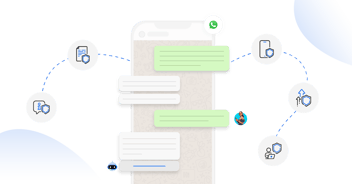The digital transformation across the industries changes the traditional roles and responsibilities of CIOs, and InsureTech is no exception. Traditionally, the CIO role focused on the Information Technology (IT) strategy, initiatives, and implementation. Most of these responsibilities were inward-looking, in the sense that they looked at optimizing organizational efficiencies and information flow. However, the siloed organizations are no longer relevant, and the role of CIOs is expanding to assume a more business-oriented outlook. It is becoming more customer-centric and aims at optimizing the customer experience (CX) and engagement.
Thankfully, the technology evolution supports InsureTech CIOs to adapt to the changing dimensions of their role quickly. As technologies like Machine Learning (ML) and Artificial Intelligence (AI) mature, tools like Insurance chatbots leveraging them equip CIOs with unparalleled capabilities. This article will discuss the changing contours of the InsureTech CIOs role and how these new-age tools can help them meet the fast-changing requirements.
How Is the Insurance Industry Changing?
An increasing number of new entrants, the emergence of disruptive innovation, the introduction of various business models, including sharing economy, lead to a surge in demand for innovative technology solutions from Insurance players. These creative solutions must be customer-centric and should be able to provide value to the customers of insurance companies.
As the world becomes more connected than ever, the need for better technology in the insurance sector is also increasing. The connected world is why technology has become the cornerstone for the growth of the insurance sector. Insurance companies are facing challenges related to the technological aspect of the business. Managing all the data is a challenging task for insurance companies. With this vast amount of data at hand, it becomes difficult for the insurance executives to work with it and obtain meaningful insights to help them understand, address, and acquire the customers better. Hence, the role of emerging technology tools is becoming more prominent across the insurance value chain.
Critical Challenges for InsureTech CIOs
InsureTech is changing the landscape of the insurance business. We are now in the midst of a paradigm shift, and the customer journey is changing with it. What was once a linear path is now a complex maze that requires significant attention. To deal with its complexity, the InsureTech CIOs are expected to be jack-of-all-trades. Today's CIO has to be able to comprehend the business, as well as the technical solutions. They need to understand a broader strategic business priority that encompasses all business facets rather than the traditional backend role so far. Companies expect today's InsureTech CIOs to serve emerging strategic business priorities through technology solutions. These expectations include developing strategies that will help the company grow and thrive in an increasingly digital economy.
As digital transformation becomes an integral driver of every business, CIOs must shift their focus from what they have done in the past to how they will need to handle the future of technology and business. To meet the changing expectations from the role, the insurance CIOs must address a few primary challenges. Let's discuss a few of these challenges in detail.
Leverage Vast Existing Data
Insurance is a data-intensive sector. Insurance firms have amassed a massive amount of data. Additionally, new data is generated with every customer query and transaction. The CIOs' primary challenge is to put these existing and incoming data to create better internal operations insights and improve their customer-facing aspects. The first step of this challenge is to improve the quality of the information being generated out of the data and then get valuable insights through better analysis. The second step is to make these insights available to business decision-makers to make better decisions. The CIOs will also need to provide customers with better CX using these insights.
Autonomous Customer Service
With changing contours for customer service availability requirements that demand 24/7 and omnichannel access, ensuring uninterrupted and continuous customer services is another huge challenge for CIOs. Changing customer expectations directly impact business growth, as poor CX can drive away more than one-third of your customers.
On the one hand, excessive focus on internal efficiencies and scalability hamper customer satisfaction. Traditional implementations of Interactive Voice Response (IVR) systems are a prime example of that. On the other hand, handling spikes in customer requests and responding to them any time of the day promptly and accurately is a resource-intensive endeavor. CIOs will need to figure out how to enable self-service capabilities while ensuring continuous service availability beyond the time and geography constraints.
However, there is a human element to it too. CIOs still need to ensure adequate human support when required, as customers may want to speak to humans. These hand-offs need to be seamless, and the customer should find the entire experience smooth.
Innovation
While the data analysis and customer interactions are critical, they are still insufficient to provide the businesses a competitive edge. Without utilizing the valuable insights gained through the analysis to develop a differentiating factor that sets you apart from your competitors, you may become enough, but not the best.
The innovation needs to be all-encompassing, in the sense that, on the one hand, it needs to improve how the business interacts with the customers. On the other hand, it also needs to understand the "what" of the interactions. The "what" can be customized product offers, appropriate support and education, or proactive alerts and notifications that benefit the customers.
Operational Efficiencies
The CIOs are expected to support the organization's business transformation by improving the quality of the IT service offerings and reducing costs through innovation. By ushering in digital transformation, they are expected to enhance service delivery functions while minimizing the risks of competitive business environments and threats of frauds and other financial risks. CIOs have a pivotal role in supporting business intelligence and operational workloads with the increased focus on analytics and service-oriented processes and technology implementation.
CIOs can drive process and delivery efficiencies of insurance companies ' internal operations by working on these four critical areas of focus. Simultaneously, by enabling better information flow and utilization through intelligent and agile technology evolution, they can impact business growth through better customer engagement.
How Is Evolving Technology Helping CIOs In InsureTech?
The digital transformation efforts of Insurance and InsureTech are primarily driven by the advent of mature Machine Learning (ML) and Artificial Intelligence (AI) technologies. These technologies cover the entire spectrum of insurance operations, from marketing to delivery and customer interactions to business process optimizations. From the customer interactions perspective, ML and AI are increasingly supporting insurance companies through chatbots. New InsureTech capabilities powered by ML & AI and implemented through Insurance Chatbots drive the customer experience. The buyers also find chatbots to be an effective medium to communicate with businesses. According to a study, 47% of buyers are more likely to purchase a product via a chatbot.
While chatbots' primary benefit is to bring natural, conversational patterns to customer communication, they can help the InsureTech CIOs with much more by utilizing the underlying algorithms. Let us understand how CIOs benefit by implementing intelligent chatbots to respond to the challenges and changing expectations.
The Data Dimension
Machine learning and Artificial Intelligence benefits from the amount of data available to them to improve their accuracy. Given these requirements, these algorithms are implemented in a manner that is capable of analyzing a vast amount of data at high-speed and find relevant insights. Insurance chatbots utilize this characteristic of the underlying ML and AI algorithms to provide meaningful, real-time answers to customers through natural conversations like between two humans.
Through such data analytics, the chatbots can provide safe-guards for both customers and the insurance companies for the conversations, data and document exchanges, and transactions. As more data is captured into the data stores, CIOs can improve results to identify risks and frauds. Through reduced vulnerabilities, insurance companies can reduce operational costs and make service delivery much more efficient.
Democratizing Customer Service
These chatbots' AI-powered conversational interfaces provide ease of communication for customers, 24/7 access without any geographical boundaries. Not only that, the chatbots are available across multiple channels. Earlier, the communication channels were limited and isolated. If a customer started the interactions via a phone call and needs to use email for some reasons later, they had to repeat themselves by providing the entire context and the earlier phone call references. It was still difficult for the insurance companies marketing and support agents to get the complete picture. Often, there was no way to assimilate the data and information from these disparate channels.
Chatbots can be deployed across multiple channels. These include web, mobile, other messenger and chat applications including Slack, Facebook Messenger, WhatsApp, and many other similar media. The omnichannel experience goes beyond just the availability, though. The omnichannel insurance chatbots can provide seamless context switching between channels. No matter what channel a customer chooses and if or when they switch to another channel, the conversation can flow as a single thread. Not only that, but the omnichannel chatbots also include the capabilities of human hand-offs where they can pass on the conversation to a human. While this hand-off, the chatbots can also pass-on the relevant information from earlier conversations to the human agent to have the entire context. The customer doesn't need to repeat themselves.
The omnichannel capabilities help CIOs with innovation and growth strategies as it enables them to learn a variety of customer traits and preferences.
Ushering In the Innovation
Chatbots allow insurance CIOs to facilitate innovation by making it possible to understand the customers better. Such understanding includes customer demographics, and the behavioral patterns, preferences, and any other customer attributes that may influence their insurance decisions should be understood and analyzed.
Through Natural Language Understanding (NLU), the evolving AI allows the CIOs to learn previously unavailable attributes and customer satisfaction characteristics. These insights help CIOs drive innovation through technology.
InsureTech CIOs can drive the personalization of products, information, and buyer journeys through such enhanced understanding. Personalization is fast becoming a vital distinguishing factor for competitive advantage. Chatbots prove to be excellent delivery agents for personalized services. What's even more beneficial is that chatbots can intelligently form personalized journeys in real-time if they learn something new through the ongoing conversation with a customer using Mood Analysis and Context Analysis algorithms. Such intelligent personalization and service delivery ensures better customer engagements and creates opportunities to acquire competitive advantage through enhanced opportunities.
Better and Optimized Processes, Reduced Costs, Increased Value
The chatbots can function across time and geographic constraints at scale. They can serve a large number of customers simultaneously without affecting the speed or quality of service. The insurance chatbots allow CIOs to scale the customer-centric operations without additional costs and administrative efforts. They allow for lean organizations through increased efficiencies, automation, and quality of customer interactions. As a result, insurance CIOs can quickly scale their company's customer-centric operations without having to worry about spikes or exponential costs. A Juniper study estimates that by 2023, insurance companies would save $1.3billion through AI-chatbots adoption.
As technology continues to advance, companies are focused on delivering the most streamlined operations possible. With insurance chatbots, rather than focusing on the technology itself, CIOs evolve their role from overseeing technology to being the expert on business operations and efficiency. This evolution opens up opportunities to help drive operational efficiencies that will lead to success.
To Sum Up
The insurance industry expects the CIOs to transform from enablers of information to enablers of customer satisfaction and business growth through digital transformation. More than 76% of companies had their CIOs as part of ideation and strategy making. They are also becoming leaders in operational execution. More than 61% of CIOs lead governance efforts, while 54% lead project management efforts.
AI-driven InsureTech chatbots are becoming the norm in a world where customer expectations have shifted. In the past, CIOs were primarily focused on implementing technology for customers and making sure it functioned properly. With more focus on strategy and delivering value to customers, AI has become an essential tool for the CIO's success. Insurance chatbots are proving to be able allies of CIOs in this transformation. With capable platforms that even allow pre-built workflows and recipes, the insurance CIOs can easily lead their organizations into the future.
Want to develop an Intelligent Virtual Assistant solution for your brand?


.png?quality=low&width=960&height=502&name=Linkedin+%20Twitter%20(2).png)









